Thuja eastern "Aurea nana": description, planting and care
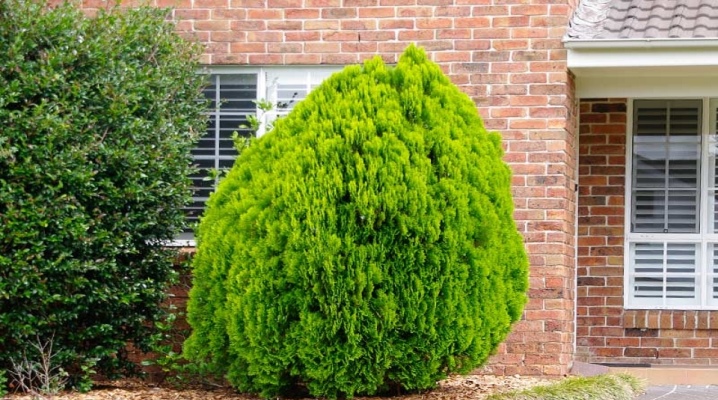
Among the huge variety of varieties and species of conifers, thuja are especially distinguished. This group of conifers has been very popular with landscape designers in Europe for many years. As an example, consider the description of the Aurea Nana variety.
Features of the variety
Thuja eastern "Aurea nana" is a very interesting dwarf variety, the needles of which are golden, yellowish, and in the cold season - bronze. It grows in several trunks, presented in the form of a shrub. The plant has the following compact dimensions:
- the height of an adult twenty-year-old tree is no more than 1.5 meters;
- crown volume usually does not exceed 70 centimeters.
Thuja eastern "Aurea nana" refers to slow-growing plants. During the year, young shoots add about 5 cm in length. The branches first stretch vertically, and then, gradually expanding, the crown acquires a rounded-elongated, ellipsoidal shape. There are two types of the "Aurea nana" variety - western and eastern. In appearance, they are almost impossible to distinguish from each other.
The only difference is that the western form can grow in both sun and partial shade, while for the eastern variety it is better to choose a brightly lit area.


Where to place?
As already mentioned, the eastern thuja "Aurea nana" refers to light-loving cultures. It is better to plant it in a sunny place, although the tree will rather calmly react to a very small shade, especially during hot hours. Thuja can be planted both in spring and autumn. However, experts, as well as many amateur gardeners, note that in the spring the bushes get sick less, take root better, during the warm season they manage to get stronger and prepare for wintering. The plant prefers slightly acidic loose soil.
Landing includes the following highlights:
- the planting hole is dug to a depth of 50-60 centimeters; width - about twice the volume of the roots of the seedling;
- thujas love wet soil, but they cannot stand flooding and close groundwater, therefore, drainage must be laid on the bottom of the pit - 20 centimeters of expanded clay, gravel or crushed brick;
- a soil mixture consisting of turf and peat in a one-to-one ratio is poured onto the drainage layer on top;
- filling the hole to half, set the seedling in the center and carefully add the remaining soil;
- then the earth around the stem is compacted, trampled down a little, well watered;
- to reduce moisture evaporation, the trunk circle is mulched with finely chopped pine bark, chips or peat;
- when planting, you need to make sure that the root collar of a young bush is flush with the top layer of soil.

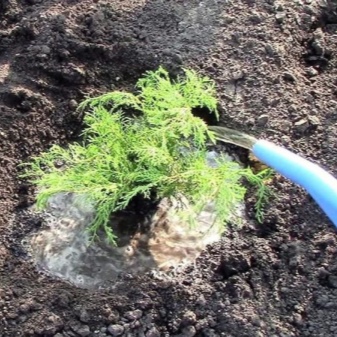
How to care?
Thuja orientalis is a rather unpretentious culture. In the first summer, young plants need frequent and abundant watering - at least twice a week, depending on weather conditions. In addition, in extreme heat, the bushes will be very grateful for spraying and sprinkling. Then you can reduce the frequency to 1 time in 7-10 days, but in no case should the earth in the near-trunk circle be allowed to dry out. Care consists in timely weeding, loosening the soil after each watering or rain and adding an additional layer of mulch.
The eastern variety, in contrast to the western one, has less frost resistance, therefore, in late autumn, before the onset of cold weather, young plantings are sheltered. In this form, thuja tolerates frosts and strong winds well, but the bright spring sun can have a detrimental effect on it, from which burns appear on the bark and delicate needles suffer. Therefore, in the spring, it is necessary to fix a light covering material in the form of an awning over the plantings. In spring, sanitary pruning is carried out, removing damaged and dried branches. This variety does not need to be formed, since it itself forms an attractive crown in the form of a slightly elongated ball.
For better growth and development, it is useful to feed the plants. In the spring, nitrogen-containing fertilizers are applied, during the summer those containing phosphorus will be useful, and, finally, in the fall - potash fertilizers. The eastern thuja "Aurea nana", like all other types of thuja, should never be fed with humus, including manure. The tree may die from this.
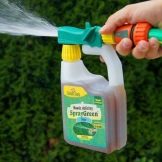



What is it combined with?
Due to its compact size and attractive appearance, thuja "Aurea nana" is widely used in landscape design. Shrubs planted at close range form a dense and beautiful hedgethat does not need to be constantly trimmed and straightened. These plants will decorate an alpine slide or a rocky garden, they will look original in the center of a flower bed with bright red or blue annual flowers, in a single or group composition on the lawn.
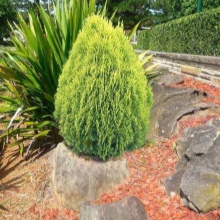
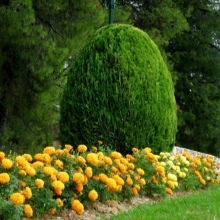
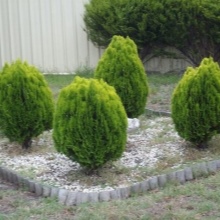
Thuja will perfectly fit into the company of other low-growing conifers and deciduous crops, especially with a contrasting color of leaves or needles. An example is the combined planting of blue spruce trees (in the background) and thuja of the eastern "Aurea nana" in front. A zest to this composition will add a frame made of wild or artificial stone of grayish shades. Small bushes in elegant pots and pots can be placed on the balcony, loggia, terrace, placed on the site, next to the gazebo or porch of the house. This variety will be especially appropriate in small gardens, where every free meter of land is very highly valued.
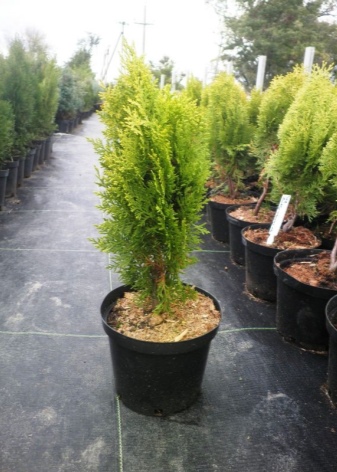
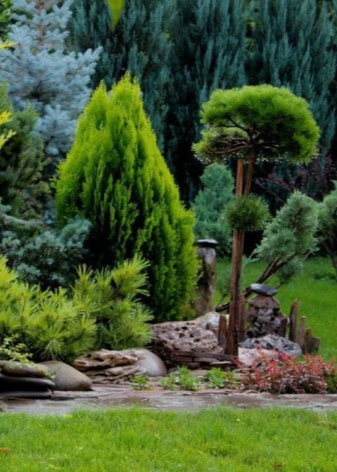
Below is an approximate list of some of the plants that thuja is combined with:
- barberry Thunberg;
- weigela hybrid;
- rose (white-colored varieties look great);
- magnolia;
- Potentilla (Kuril tea);
- spirea Wangutta;
- forsythia is European;
- heather;
- hydrangea;
- rhododendron;
- early flowering perennial species such as primrose, bergenia, tulips;
- bulbous, suitable shades;
- various bright annuals;
- hosts;
- undersized ground cover plants.
Important! When choosing neighbors for thuja, it must be borne in mind that the requirements for the composition of the soil, moisture, lighting should practically coincide.
Thuja eastern "Aurea nana" will be an adornment of any garden or personal plot and will delight with its appearance all year round.

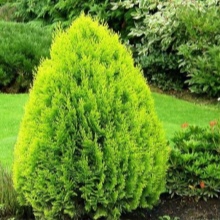
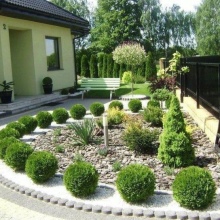
How to care for the eastern thuja "Aurea nana", see the next video.



































































The comment was sent successfully.